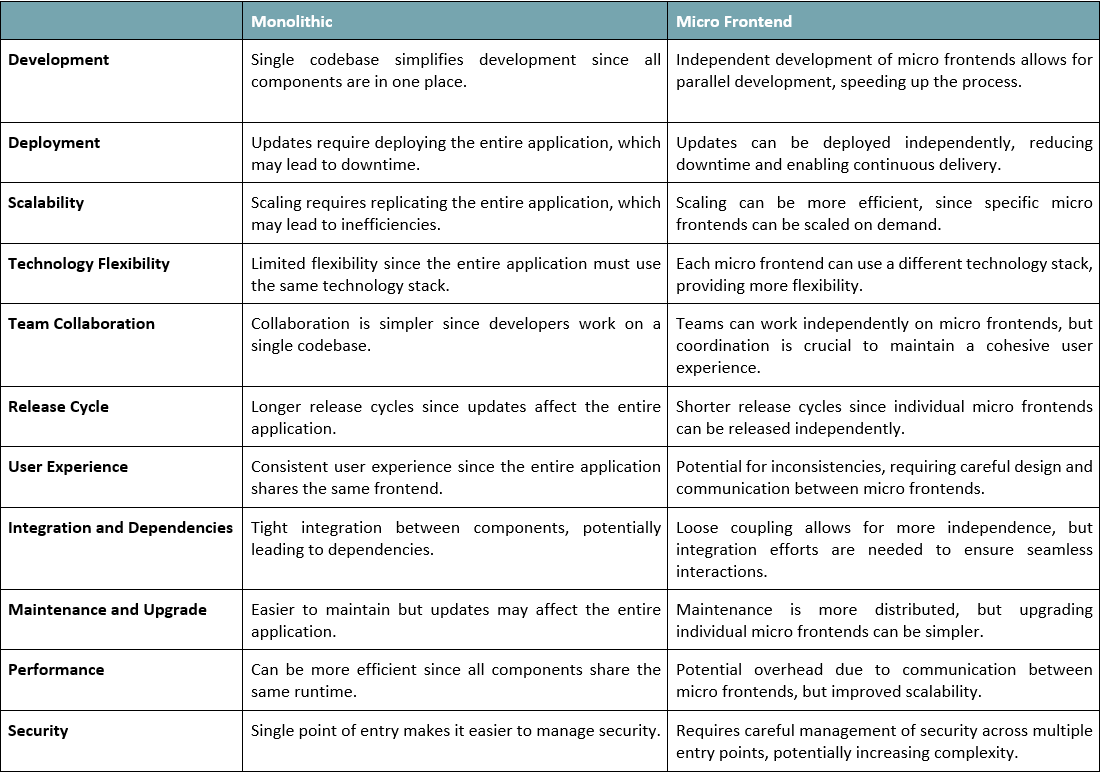Micro Frontend Architecture: Exploring the Key Features, Advantages, and Patterns
The author of this article is EPAM Senior Software Engineer Anjani Tharayil.

Other articles by this author:
Monolithic vs micro frontend architecture
Monolithic architecture consists of a single, tightly integrated codebase in which all frontend components are developed and deployed together. While monolithic applications are initially simpler to manage, they can become challenging to scale and maintain as they grow in complexity.
In recent years, the adoption of micro frontend architectures has become more popular as companies strive to enhance the scalability, flexibility, and maintainability of their web applications. Micro frontend architecture involves breaking down a web application into smaller, independently deployable and scalable frontend modules that can be developed and deployed by separate teams. This fosters agility and enables parallel development.
In this article, I start by comparing monolithic and micro frontend architecture in various contexts, and then delve into various micro frontend architectural patterns, exploring their advantages and use cases.
Main features of monolithic and micro frontend architecture

Below is a comparison using an e-commerce app as an example:

Micro frontend architectural patterns
1. Module Federation
Module Federation is a popular micro frontend pattern that enables the dynamic loading of independently developed and deployed modules at runtime. This approach fosters loose coupling between frontend components and promotes encapsulation. With Module Federation, each micro frontend is responsible for exposing specific modules, which can then be consumed by other micro frontends. This pattern leverages Webpack to facilitate module loading and communication between micro frontends.
Advantages:
- Dynamic module loading enhances runtime flexibility.
- Loose coupling between micro frontends promotes autonomy.
Use cases:
- Large-scale applications with multiple development teams.
- Complex projects requiring independent development and deployment cycles.
2. Shell and Remote
In the Shell and Remote pattern, a shell application acts as the container for remote micro frontends. Each micro frontend is developed and deployed independently, exposing a remote entry point. The shell application dynamically fetches and integrates the remote micro frontends at runtime. This pattern is effective for projects with a clear separation between the shell's core functionalities and the micro frontends' specific features.
Advantages:
- Centralized control in the shell application.
- Isolation of micro frontend development and deployment.
Use cases:
- Enterprise applications with modular features.
- Projects requiring a consistent user experience across various micro frontends.
3. Single-SPA (Single Page Application)
The Single-SPA pattern allows different micro frontends to coexist within a single page application. Each micro frontend is an independent SPA, using a shared routing mechanism to navigate seamlessly between micro frontends. This pattern is suitable for projects in which components have different technologies, frameworks, or lifecycles.
Advantages:
- Independent development and deployment of micro frontends.
- Coherent user experience within a single page application.
Use cases:
- Legacy applications transitioning to micro frontend architecture.
- Projects with diverse frontend technologies.
4. Widget Composition
Widget Composition is a micro frontend pattern in which small, self-contained widgets are developed independently and later composed to form a complete user interface. Each widget encapsulates its logic, styling, and functionality. This pattern is especially effective for projects requiring rapid development and deployment of specific features.
Advantages:
- Quick development and deployment of individual features.
- Reusable and modular widgets.
Use cases:
- Dashboards with customizable components.
- Projects requiring a high level of flexibility in feature composition.
Conclusion
Micro frontend architecture offers a powerful solution for organizations seeking to enhance the modularity and scalability of their web applications. Choosing the right architectural pattern depends on the specific requirements and constraints of your project. Whether it's Module Federation, Shell and Remote, Single SPA, or Widget Composition, adopting a micro frontend approach can increase development speed, improve maintainability, and make frontend architecture more resilient.

.png)
